ABSTRACT
As the belief that developing human capital is the best hedge against constricting budgets and uncertainty gains traction, initiatives at the U.S. Army War College reflect the Chief of Staff's vision of a top-level intellectual rebirth. The school assessed its academic program and has pursued improvement under the rubrics of faculty, curriculum, students, and integration. Odierno's ideal is officers capable of abstract strategic thinking, and faculty are being challenged to upgrade through scholarship vice being merely good teachers while students will be subjected to greater rigor than the old pass-fail system and will have a wider array of activities they can prioritize en route to holistic development. Further effort will center on encouraging closer teamwork among the college's component organizations.
The end of American combat operations in Iraq and Afghanistan marks the start of a new interwar period for the U.S. Army. Like its predecessors, the emerging period will see dramatic declines in military budgets and manpower. Congress already has legislated steep reductions in defense spending that will lead to corresponding reductions in Army programs and personnel. Under current plans, the personnel strength of the Active-duty Army will shrink from 570,000 to 490,000 by 2015, and even steeper cuts are now on the table.1
Given the uncertain budgetary and security environments, the Army’s most senior leaders have resolved to invest in human capital as the best way to prepare for future challenges. Chief of Staff General Raymond T. Odierno, for example, called for an “intellectual renaissance” that would revitalize professional education and produce officers increasingly capable of thinking through the most difficult problems, especially at the strategic level.2 General Robert Cone, commander of U.S. Army Training and Doctrine Command, also called for improving senior-level education. He cited the need at the U.S. Army War College to strengthen the faculty, modify the curriculum, and invest in the best equipment and facilities. According to General Cone, “There is no reason not to demand the equivalent of . . . a Princeton-level education in strategy from the Army War College.”3

62nd Operations Group executive officer briefs international fellows from U.S. Army War College on scientific research mission in Antarctica supported by Airmen from Joint Base Lewis-McChord (U.S. Army/Jennifer Spradlin)
This article reports on the initiatives now under way at the Army War College to strengthen its educational program. These initiatives are taking place in the context of educational reform across the military Services.4 Chairman of the Joint Chiefs of Staff General Martin Dempsey spearheaded the larger effort by ordering a review of joint professional military education that has generated productive debate among military and civilian educators.5 By rendering this report on the Army War College, we seek to further the multi-Service debate on the value of senior-level education and the best practices for conducting it.
Institutional Assessment
In the summer of 2012, General Odierno directed the War College to conduct an institutional self-assessment and recommend improvements to strategic-level education. The self-assessment revealed, on the one hand, that the War College had successfully adapted its academic program to the challenges of fighting two concurrent wars. It confirmed, on the other hand, the need to retool that program now that the wars were ending and to redress problems associated with academic governance. On the latter points, many critics of senior-level education have made similar assertions in a corpus of literature too compelling to ignore.6 One such critic, a former military faculty member at the War College and now a professor at a civilian university, characterized the War College as “good, but not great”; the gap between what the War College “was and what it could be” was one of his “greatest frustrations” as a faculty member.7
On the heels of the institutional self-assessment came a strategic review of the academic program. Begun in October 2012, the review lasted 9 months and involved faculty and staff from across the institution. Broad-based participation ensured transparency of process and leveraged the collective wisdom of those who knew the institution best. Additionally, it encouraged widespread support of the initiatives resulting from the review and allowed early implementation of the changes targeting the most pressing institutional needs.8
The changes resulting from the self-assessment and academic strategic review fell into four broad categories: faculty, curriculum, students, and integration. Within each area was a set of goals that would form the nucleus of a change plan. This article describes the most important initiatives.
Faculty
Nothing is more important to the success of an educational institution than the quality of its faculty. The War College faculty—a blend of civilian educators and military officers of all Services—was strong, but institutional policies sapped its potential. The principal problem was the laxity of academic promotion standards, as faculty members only needed to be good teachers and loyal employees to ensure their continued employment. Pay increases depended more on seniority than the usual standards of academic excellence: teaching, scholarship, and service. Most War College faculty members were indeed fine teachers and public servants, and some engaged in serious research and writing. On the whole, however, the civilian faculty dismissed scholarship either as unnecessary or low priority. It was not entirely their fault, as the War College had placed a heavy emphasis on teaching and therefore did not require scholarly output from most of the faculty.9
To reorient expectations, the War College implemented a major revision of the policy governing the civilian faculty. While acknowledging the primacy of teaching, the new policy jettisoned the assumption that the War College, as a professional school, should not require its faculty to engage in scholarship. On the contrary, it emphasized that civilian faculty members must “apply themselves to serious engagement with a body of professional literature and produce scholarly work that is insightful, wise, and deeply informed. . . . Engaging in scholarship and bringing that scholarship into the classroom is the mark of a self-confident, energetic faculty that values its own knowledge, wisdom, and insight.”10
The new policy divided the faculty into three tracks—academic, practitioner, and research—to accommodate the variety of functions performed by the civilian faculty. Those in the academic track are primarily the Ph.D. faculty whose principal duty on most days is teaching. Practitioners are primarily teachers also, but they tend to be non-Ph.D. holders who possess niche expertise needed for professional military education. Faculty members in the research track focus primarily on research, writing, and publications that answer the needs of the Army and the War College curriculum.11 Regardless of track, all faculty members must meet rigorous standards of excellence to be promoted, and all are expected to excel in teaching, scholarship, and service to varying degrees.
In conjunction with the new faculty standards, the War College adopted a revised salary schedule that favors performance over longevity. Henceforth, a faculty member’s academic rank depends solely on credentials and performance, not longevity, and his or her pay is calculated accordingly. Under the new pay policy, an assistant professor may not earn more than an associate professor, who may not earn more than a full professor. The pay bands are wide enough to accommodate the compensation requirements within each academic rank and discipline; more important, they serve as powerful incentives for faculty excellence.12
The heightened expectations for the faculty came with commensurate resources and opportunities. Starting in academic year 2013–2014, for example, full-pay sabbaticals expanded from 6 to 10 months (every 7th year). Additionally, the new policy encouraged faculty members to apply for other forms of voluntary absences—administrative leave with pay, leave without pay, and temporary external assignments—to engage in scholarship and service.13 While these absences add incrementally to the workload of the present-for-duty faculty, they provide valuable opportunities for professional development and high-level contributions to the Army, Department of Defense, and other governmental organizations.
Another faculty-related initiative was the creation of a permanent faculty council. Following its inaugural meeting in October 2012, the council quickly established itself as an influential source of advice on policy issues and a venue for voicing faculty concerns.14 Its leaders pushed aggressively for needed changes; they developed the faculty promotion standards described above and took the lead in many of the initiatives discussed below. During academic year 2013–2014, the faculty council established a formal charter that institutionalized that body as an instrument of governance for the long term.
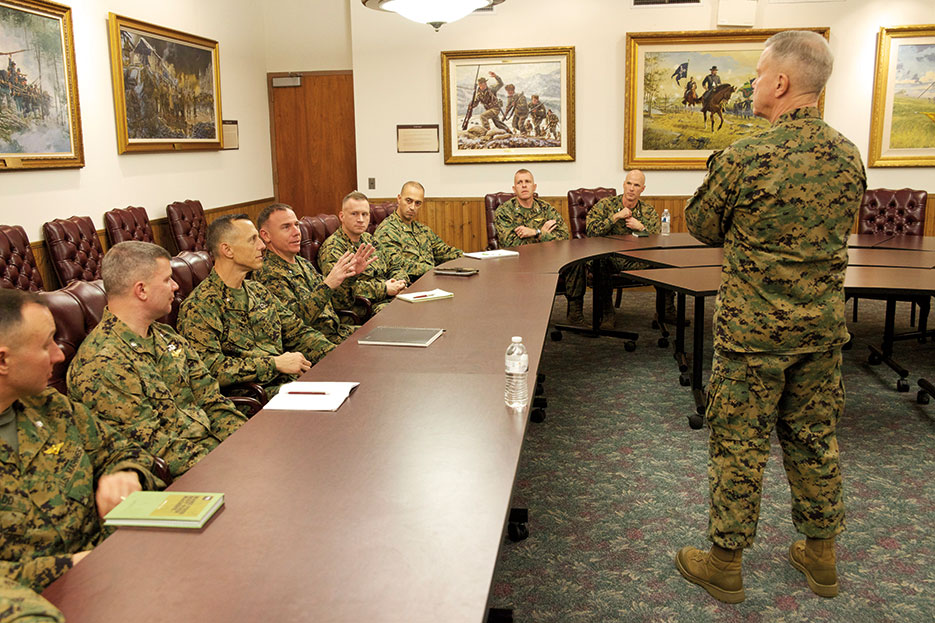
Marine Corps Commandant General James F. Amos addresses Marine students in commandant’s conference room at U.S. Army War College (U.S. Marine Corps/Mallory S. VanderSchans)
Curriculum
The War College’s core curriculum grew significantly over the past two decades. In the early 1990s it consisted of four courses that ended by mid-December, but it reached into early March by academic year 2006.15 The growth was due primarily to the exigencies of war, and it responded to the requirements placed on the War College from the Department of the Army, combatant commands, and the Joint Staff for greater emphasis on practical subjects. Course directors were conscientious in adding lessons and class hours, but the result was increased redundancy in the curriculum and less ability to tailor the War College experience to each student’s specific needs. More significant, a longer core curriculum did not necessarily equate to a stronger educational experience. According to a former visiting professor well versed in professional military education, the expanded curriculum focused heavily on process—“planning, organization, employment, administration, service/defense/joint/interagency process, and the like—a kind of graduate-level national defense ‘civics.’” As a professional school, the War College could not ignore these subjects, but their extensive coverage in the core curriculum left less time for higher level learning.16
Another curriculum-related problem was the inability to assess student performance beyond the pass-fail system in each course and the student surveys at the end of the year.17 Students spent much time in seminar, but there were inconsistent standards of performance from one classroom to the next and no reliable method of assessing student learning across the core curriculum. As a result, the faculty could not adequately measure how well students had mastered the institutional learning objectives that guide curriculum development.
Several initiatives are addressing the above concerns. First, a new set of institutional learning objectives—a product of the academic strategic review—sharpened the focus on higher level learning (table 1). The new objectives place added emphasis on critical and creative thinking, especially in dealing with surprise, uncertainty, and change. Additionally, they address the need to communicate clearly, persuasively, and courageously and to embrace the values of the professional ethic in the context of military leadership and decisionmaking. Finally, they reinforce the traditional focus on subjects related to strategy formulation and the employment of military forces at the strategic level.18
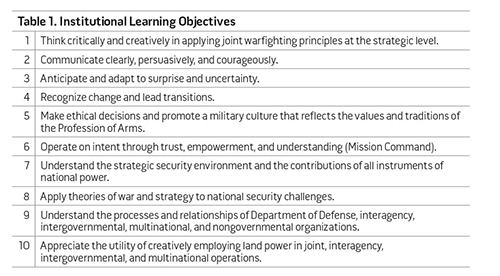
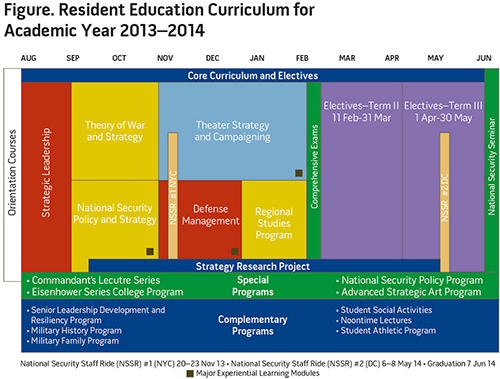
A second initiative shortened the core curriculum by over a month—the result of an internal study showing redundancy in meeting the learning objectives for each course.19 The shortened core courses came with new requirements for oral presentations to exercise students’ speaking abilities; additionally, they included a focused writing program to help students communicate effectively with policymakers. As part of the latter effort, the War College extended the deadline for completing the strategy research project—the culminating written requirement of the academic year—by nearly a month to allow more time for research, analysis, and writing. Another salutary effect of the shortened core curriculum was to enable students to take more electives in their areas of interest and thus add relevancy to the educational experience.
A third major change concerned course scheduling. Previously the core courses progressed sequentially, providing an orderly handoff from one academic department to the next. While administratively simple, sequential scheduling complicated student efforts to integrate the concepts of various courses, so the War College adopted concurrent instruction to facilitate concept intergration starting in academic year 2013–2014. As an example, Theory of War and Strategy, primarily a history and theory course, and National Security Policy and Strategy, primarily a political science course, were taught on the same day, each with 80-minute lessons. Alternatively, Theater Strategy and Campaigning, primarily a war-planning course, was taught on alternating days first with Defense Management, primarily a resource-planning course, and later with electives in the Regional Studies Program. The figure shows the placement of concurrent courses during the academic year.
As of this writing, the War College is assessing the effectiveness of concurrent instruction relative to sequential instruction. The results of the assessment will determine whether concurrent or sequential instruction—or some combination of the two—will be the method of choice in the future. So far, student and faculty feedback has been mixed, particularly toward the practice of same-day classes in two separate courses; hence the likelihood of continued experimentation in this area is high.
While the initiatives described above focus mostly on the scope and delivery of existing courses, a separate initiative is under way to review the content of the curriculum as a whole. The review will proceed through 2014 and conclude in time to implement the new curriculum during academic year 2015–2016. The most important design criterion is to emphasize the learning tasks associated with education over those associated with training. Accordingly, the new curriculum will elevate analysis, synthesis, and evaluation over knowledge, comprehension, and application.20 Strategic leaders must indeed know, comprehend, and apply, but their greatest value to the Army and the Nation will be the ability to think at higher levels. Another feature of the new curriculum will be renewed emphasis on historical analysis. In all core courses, historical case studies will provide students a common base of understanding and a framework for analysis, synthesis, and evaluation.
Perhaps the most significant curriculum-related change, and the source of greatest angst for students, is the oral comprehensive exam, begun on a trial basis in academic year 2012–2013. The exam typifies that of other graduate programs by requiring each student to engage intellectually with a team of faculty members for up to an hour. It tests a student’s ability to integrate course concepts into a coherent framework of knowledge, think strategically, and communicate effectively. Collectively, the exams reveal areas of curricular strength and weakness to the faculty. As evidence of the exam’s rigor, 14 students failed on the first try and 2 failed the make-up.
The oral comprehensive exam received overwhelmingly positive reviews from students during the pilot year and has since become a graduation requirement.21 Henceforth, students who fail the exam and the make-up will appear before an academic review board and likely will not receive a War College diploma. Additionally, they will face whatever administrative action their Services deem appropriate.
Students
The resident student body at the War College represents a diverse assemblage of intellectual and professional talent. As shown in table 2, roughly 60 percent of the students are Army officers, including about 20 percent from the Reserve components. The rest are officers from other Services, civilians from Federal agencies, and officers from friendly nations— “international fellows.”

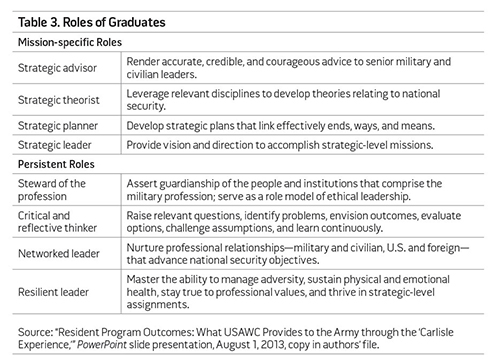
War College students stay busy during the school year. While academics take up the most time by far, students avail themselves of a wide range of extracurricular activities offered at Carlisle Barracks, the idyllic Army base in historic Carlisle, Pennsylvania. The totality of the War College year, academic and nonacademic, is known informally as the “Carlisle experience” by the generations of graduates who remember it fondly. Despite the happy memories, however, the amalgam of activities comprising the Carlisle experience had always been more the result of happenstance than institutional design. As a result, the developmental benefits were less than they might have been.
In early 2013 the War College formalized its approach to enhance the professional development of students. The new “Carlisle Experience” program requires the school to prioritize the myriad activities available to students during the academic year. The intent is to create an environment that develops students holistically and, in particular, helps them make the difficult transition from tactical to strategic leaders. As part of the program’s implementation, the faculty developed a list of roles associated with strategic leadership. Some are mission specific, such as planning and advising at the strategic level, while others are persistent, such as critical thinking and being a steward of the military profession. Table 3 lists the most important roles in each category.
With these roles in mind, the War College prioritized all the activities available to students. The academic curriculum obviously received the highest priority and greatest resources because it prepares students for most of the mission-specific and persistent roles of strategic leaders. Other activities such as noontime lectures and family resiliency training received less priority but still merited institutional resources to varying degrees. Still others such as social events and civilian community programs had the lowest priority. They were advertised to students but came with no resources. As a new program, the Carlisle Experience will improve with time, but the underlying principle of coordinating academic and nonacademic activities to achieve the best developmental effect is unlikely to change.
In addition to the Carlisle Experience, another student-focused initiative is recognition of superior academic performance. The War College had long favored a pass-fail system for each course and for the year as a whole, as opposed to letter or numeric grades. The intent was to mitigate the ill effects of competitiveness within the small groups of students assigned to each seminar; additionally, the policy recognized that students arrived with different levels of preparedness for graduate education. The pass-fail system resulted in virtually every graduate receiving an academic evaluation report noting that he or she “met course standards.” No one received an “exceeds course standards” rating, thus rendering the academic evaluation report professionally meaningless.22
Starting in academic year 2013–2014, students will receive numeric course-end and year-end grades that reflect the quality of their work. Based on those grades and other criteria, the best will be recognized as “distinguished graduates” on the academic evaluation report. The primary reasons for the change are to apprise students of their academic progress and inform the Services of their most intellectually talented officers. Additionally, the War College can now recognize deserving students in ways similar to the honors accorded high achievers at respected colleges and universities elsewhere. To do otherwise would invite conjecture about the quality of the curriculum and promote the belief that the War College coddles poor performers—precisely the perceptions the War College wishes to dispel.
Also in academic year 2013–2014, the War College is requiring students to access course materials through mobile computing devices. The change was meant to familiarize students with technology that is becoming standard across the Services. With this goal in mind, the school purchased over 500 tablet computers for use by students and faculty and uploaded unclassified course materials on cloud-based servers. Additionally, it improved wireless connectivity in academic buildings across the campus.

General Dempsey speaks at U.S. Army War College (DOD/Chuck Marsh)
On the positive side, students and faculty who were not already using mobile devices are quickly learning how. Tablet computers have become as ubiquitous as notebooks (the paper kind) in seminar rooms, lecture halls, and libraries, and they routinely accompany students to the athletic fields. Faculty members are likewise getting more comfortable with the devices in and out of the classroom. On the negative side, some students and faculty are frustrated by the inherent limitations of mobile devices such as slow downloads, broken links, small screens, and the quirkiness of certain applications.
The most important consideration in assessing the utility of mobile devices is their effectiveness as learning tools. A growing body of research suggests that electronic devices work better for readings that are short and descriptive rather than long and analytical. In the former case, the reader can glean the necessary information quickly and move on to another task; in the latter, reading comprehension may suffer from the inability to negotiate the text in an intuitive and tactile way.23 In the absence of definitive scientific answers, the War College must carefully assess its experiment in mobile computing to determine which academic materials are best delivered electronically or by the printing plant. Answers are needed soon; starting in academic year 2015–2016 students will be required to have their own mobile-computing devices to access course materials.
Integration
A principal finding of the academic strategic review was that the War College’s component organizations could and should work together more effectively. While the School of Strategic Landpower shoulders the heaviest academic burden with its resident and distance education programs, the centers and institutes provide much support. Table 4 lists the names and principal missions of the component organizations.
The emphasis on integrating the school, centers, and institutes is yielding results. The School of Strategic Landpower incorporated the annual strategy conference—an event planned and executed by the Strategic Studies Institute for the benefit of the Army—into its resident curriculum. The wargames conducted by the Center for Strategic Leadership and Development now benefit from the participation of the students (especially the international fellows) and faculty from the School of Strategic Landpower; conversely, the school benefits from the opportunity to apply academic theories and concepts to contemporary security problems. The Army Heritage and Education Center assumed control over all library operations at the War College, including the superb facility formerly organic to the School of Strategic Landpower. The combined library offers students greater access to the college’s archival holdings and research facilities. Faculty members from the Peacekeeping and Stability Operations Institute, in addition to their primary duties, develop course materials, teach electives, and guide student research in the School of Strategic Landpower.
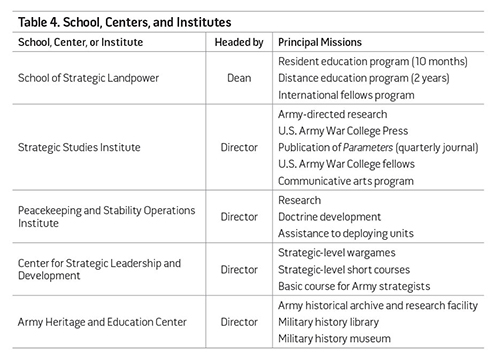
Publication is another activity that benefits from better integration. In past years, each organization within the college published its scholarship independently and under a separate cover. The effect was to obscure the totality of the scholarly work emanating from Carlisle Barracks and reduce efficiency in the publication process. The situation changed for the better in 2012 with the creation of the U.S. Army War College Press, embedded in the Strategic Studies Institute. Since then all War College scholarship conforms to the press’s publication standards and branding. Even Parameters, the War College’s quarterly journal, now displays the press’s logo to clarify its connection to the larger institution. In addition to its role in publishing official scholarship, the press serves as a convenient outlet for faculty and student scholarship on topics relating to national security.
Information technology holds great promise as a lever of integration. The academic strategic review demonstrated the desirability of improving connectivity among students, faculty, and staff at the War College. Additionally, it highlighted the potential of transforming the school into a source of knowledge and collaboration for its graduates worldwide and for national security professionals of all stripes. Toward these ends, the college established the goal of creating a networked community of scholars and practitioners consisting of its faculty, staff, students, U.S. and international graduates, and affiliates. Some pieces of the knowledge network already exist, and work is under way to improve the system. To be sure, building the knowledge network is complex and will take much time, effort, and intellectual energy, but when complete it will be one of the War College’s most powerful integrative tools.
The changes under way align with the Army Chief of Staff’s vision for an intellectual renaissance in military education at the senior level. They took shape following an institutional self-assessment and a strategic review of the academic program. Under the headings of faculty, curriculum, students, and integration, the War College has undertaken initiatives to enhance the quality of professional military education. The stakes are high, especially for a military Service facing steep cuts in personnel and resources. If the Army is to emerge from this interwar period ready to fight and win the next war, and to accomplish the many other tasks traditionally performed by land forces, the best it can do now is to invest heavily in the intellectual development of its future strategic leaders. The goal of the U.S Army War College is to help the Nation get the best possible return on that investment. JFQ
Notes
- Budget Control Act of 2011, Public Law 112-25, 112th Cong. 1st sess., S. 365, 125 Stat. 240, August 2, 2011. President Barack Obama’s proposed defense budget for fiscal year 2015 would cut Army strength to 440,000. See Nick Simeone, “Hagel Outlines Budget Reducing Troop Strength, Force Structure,” American Forces Press Services, February 24, 2014, available at <www.defense.gov/news/newsarticle.aspx?id=121703>.
- Raymond T. Odierno, James F. Amos, and William H. McRaven, “Strategic Landpower: Winning the Clash of Wills,” U.S. Army, U.S. Marine Corps, and U.S. Special Operations Command, May 2013.
- General Robert W. Cone, “The Future Army: Preparation and Readiness,” Military Review, July–August 2013, 5.
- See Gregg F. Martin and John W. Yaeger, “Break Out: A Plan for Better Equipping the Nation’s Future Strategic Leaders,” Joint Force Quarterly 73 (2nd Quarter 2014).
- General Dempsey has been a powerful advocate of educational reform in the military, as noted in several Joint Staff publications; see “Joint Education White Paper,” July 16, 2012; Capstone Concept for Joint Operations: Joint Force 2020 (Washington, DC: Joint Chiefs of Staff, September 10, 2012); Review of Joint Education: Final Report of the J7/Military Education Coordination Council, June 24, 2013.
- Examples of the literature of criticism include Joan Johnson-Freese, Educating America’s Military (New York: Routledge, 2013); Daniel J. Hughes, “Professors in the Colonels’ World,” in Military Culture and Education, ed. Douglas Highbee (Burlington, VT: Ashgate Publishing Company, 2010); George E. Reed, “The Pen and the Sword: Faculty Management Challenges in the Mixed Cultural Environment of a War College,” Joint Force Quarterly 72 (1st Quarter 2014); Gary Schaub, Jr., “A PME Survivor on How to Fix the War College: Take It Back to the Future,” Best Defense, May 23, 2012, available at <http://ricks.foreignpolicy.com/ posts/2012/05/23/ a_pme_survivor_on_how_to_fix_the_war_college_system _take_it_back_to_the_future>; and Richard H. Kohn, “Beyond Sequester: Improving National Defense in an Age of Austerity,” Joint Force Quarterly 70 (3rd Quarter 2013).
- George E. Reed, “Examining the War Colleges from an Administrative Perspective,” unpublished paper presented at the annual conference of the International Studies Association, San Francisco, April 5, 2013. Reed is a former War College student and military faculty member who culminated his military career as director of the War College’s Command and Leadership program. On retiring from Active duty, he transitioned to civilian academia and is a tenured faculty member at the University of San Diego. Despite his criticism of the War College, Reed appreciated the “intellectual awakening” he received there and the opportunity for deep thinking in national security affairs. George E. Reed, “What’s Wrong and What’s Right with the War Colleges?” DefensePolicy.org, July 1, 2011.
- “Strategic Review of the USAWC Academic Program,” author’s copy, information briefing presented at Army War College faculty call, August 16, 2013.
- A major exception was the faculty of the Strategic Studies Institute, the research and publication arm of the War College.
- Carlisle Barracks Memorandum 690-2, “Employment under Title 10, United States Code, Section 4021,” May 6, 2014, 5–6.
- Ibid., J-10 and J-11.
- The revised salary schedule went into effect in 2013. It affects faculty members who are newly hired, promoted to a higher academic rank, or reappointed.
- Carlisle Barracks Memorandum 690-2, paragraph 6.n (“Voluntary Absences”).
- Memorandum from provost to faculty council, author’s copy, “Guidance for Organizing the Faculty Council,” October 4, 2012.
- Information provided by U.S. Army War College Assessments Office, September 12, 2013.
- Richard H. Kohn, “History at the Army War College,” unpublished paper presented to the dean of the U.S. Army War College, Spring 2007. Dr. Kohn was the General Omar N. Bradley Professor of Strategic Leadership during academic year 2006–2007.
- The War College surveys its students after every core course and upon conclusion of the academic year. The responses tend to be overwhelmingly positive due to the students’ generally positive outlook and the amicable relationships developed with their instructors. On the end-of-year survey for academic year 2012–2013, 94 percent of resident students expressed a high level of satisfaction with the academic program, and 95.5 percent perceived that the overall War College experience contributed to their professional development (“very satisfied” and “satisfied” responses combined). These percentages are similar to those in other categories of the end-of-year survey; see U.S. Army War College Office of Institutional Assessment, “End of Year Survey, Resident Class, AY 2013,” August 19, 2013, 22.
- The new institutional learning objectives go into effect starting academic year 2014–2015. Objectives 1, 3, 4, 5, 6, and 7 were adapted from the Desired Leader Attributes approved by the Chairman of the Joint Chiefs of Staff. See General Martin E. Dempsey, Memorandum for Chiefs of the Military Services, Subject: “Desired Leader Attributes for Joint Force 2020,” CM0166-13, June 28, 2013.
- “Joint Learning Objectives Crosswalk,” slide presentation, author’s copy, February 18, 2013.
- >In designing the curriculum, the War College uses the hierarchy of learning objectives described in Benjamin Bloom et al., eds., Taxonomy of Educational Objectives: The Classification of Educational Goals (New York: Longmans, Green, 1956). The hierarchy, from lowest to highest, is knowledge, comprehension, application, analysis, synthesis, and evaluation. More recent versions of the hierarchy substitute “creativity” for synthesis and place creativity at the top of the hierarchy.
- Ninety-six percent of students “agreed” or “strongly agreed” that they understood the link between the oral comprehensive exam and the learning objectives of the core curriculum. See “End of Year Survey, Resident Class, AY 2013,” August 19, 2013, 21.
- Department of the Army Form 1059, “Service School Academic Evaluation Report,” March 2006, has sections for recognizing students who exceed course standards. Through academic year 2012–2013, the War College stamped over these sections with “Not used.”
- Feris Jabr, “The Reading Brain in the Digital Age: The Science of Paper versus Screens,” Scientific American, April 11, 2013, available at <www.scientificamerican.com/article.cfm?id=reading-paper-screens>.